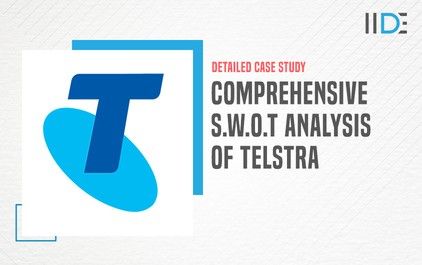About Telstra

Telstra Corporation Limited is a telecommunications company based in Australia that builds telecommunications networks as well as markets voice, mobile, internet access, pay television, among other products and services.
With 18.8 million subscribers as of 2020, Telstra is Australia’s largest wireless carrier. Telstra has recently focused on diversified products and emerging technologies after transitioning from a state-owned enterprise to a fully privatized company.
They believe that it is people who give their technology meaning. That is why their mission is to create a connected future in which everyone can thrive.
Now that we’ve covered the company’s fundamentals, let’s look at Telstra S.W.O.T analysis in the section below.
SWOT Analysis of Telstra

A SWOT analysis determines a company’s strengths, weaknesses, opportunities, and threats in comparison to its competitors.
It’s an excellent tool for determining where the firm thrives and where it falters, designing countermeasures, and determining how the organization may expand. So, in the part below, we’ll look at the SWOT Analysis of Telstra.
1. Strengths of Telstra
Strengths are an organization’s distinguishing qualities that provide it with a competitive advantage in acquiring more market share, attracting more customers, and maximizing profitability. Some of Telstra strengths are as follows:
The company has a strong base of reliable raw material suppliers, allowing it to overcome any supply chain bottlenecks.
It has fostered a culture among distributors and dealers in which dealers not only market the company’s products but also spend in educating salespeople to explain to customers how they may make the best use of the items.
- Strong distribution network:
Telstra has created a dependable distribution network over the years that can cover the bulk of its prospective market.
- Excellent Results in New Areas:
Telstra has developed competence in entering and succeeding in new markets. The expansion has allowed the company to diversify its revenue streams and reduce economic cycle risk in the markets it serves.
- Solid Returns on Capital Expenditure:
Telstra has a good track record of completing new projects and generating good returns on capital investment by establishing new revenue sources.
Telstra has a successful track record of developing new products.
2. Weaknesses of Telstra
A company’s or brand’s weaknesses are elements that need to be improved. So let’s take a look at some of Telstra weaknesses:
- Investment in Technology:
More funding for innovative technology is required. Telstra needs to invest more money in technology to unify operations across the board, given the scope of its expansion and the various geographies it plans to expand into. Currently, technological investment does not match the company’s aim.
Financial planning is inefficient and ineffective. The current asset ratio and liquid asset ratios indicate that the corporation could make better use of its cash than it is now.
R&D investment is lower than that of the industry’s fastest-growing companies. Despite spending more on research & development than the industry average, Telstra has been unable to compete in terms of innovation with the industry’s leading firms.
- Unique Selling Proposition:
The product’s marketing falls short of expectations. Even if the product is a sales success, its positioning and unique selling proposition are unclear, which could lead to competitor attacks in this market segment.
- Limited success outside core business:
Despite being one of the industry’s leading companies, Telstra has had difficulty expanding into new product sectors due to its current culture.
3. Opportunities for Telstra
Opportunities are places where a company might concentrate its efforts in order to enhance results, sales, and, eventually, profit. So, let’s have a look at what type of opportunities Telstra has to produce outstanding achievements.
- Customers acquired through the online channel:
The corporation has put a lot of money into the internet platform in the last few years. Telstra has gained a new sales channel as a result of this investment. The corporation can capitalize on this opportunity in the coming years by better understanding its customers and meeting their demands through big data analytics.
A lower inflation rate provides better market stability and allows Telstra customers to obtain credit at a lower interest rate.
Telstra may be able to tap into new markets as a result of changing consumer behaviour. It gives the company a wonderful chance to diversify into new product categories while also generating new revenue sources.
- Low cost of transportation:
Lowering the cost of transportation due to lower shipping prices can also lower the cost of Telstra’s products, providing an opportunity for the company to either increase its profitability or pass on the benefits to customers in order to gain market share.
4. Threats to Telstra
Threats are environmental factors that can inhibit a company’s expansion. The following are some of Telstra threats:
- Shortage of skilled workforce:
A skilled labour shortage in certain global markets threatens Telstra’s ability to maintain consistent profit growth in those markets.
- No consistent supply of innovative products:
Several products have been developed by the company over the years, but they are frequently in response to the development of other players. Second, the supply of new products is irregular, resulting in high and low swings in sales numbers over time.
- Imitation of the counterfeit:
Telstra’s product is also vulnerable to counterfeiting and low-quality imitations, particularly in emerging and low-income areas.
- Growing strengths of local distributors:
Local distributors’ growing power poses a challenge in some sectors, as the competition pays local distributors better margins.
Now that we’ve gone over Telstra’s SWOT Analysis in-depth, let’s wrap up the case study in the section below.









